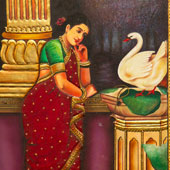Design Resource
Thanjavur Painting
The Art of Painting with Gemstone
by
Amruthalakshmi Rajagopalan, Anisha Crasto, and J. Antony William
Fixing of cloth: A wooden board of required size is procured. A cardboard is placed on the board. Cotton fabric is stretched and stuck/pasted on the board using kezhangu passai (an indigenous gum). Once the fabric has adhered/attached well to the board, the process of coating the cloth begins.
Coating the cloth board: A maavu (paste) of chukangu powder and fevicol is prepared. Three coats of this paste are applied on the cloth board over a span of ten days including drying time in between coats. This coated area is then rubbed with a smoothening stone and emery sheet to obtain a surface with mild sheen and good texture. Coating of the cloth board helps prevent the painting from damage caused by moisture and heat.
Tracing the image: The painter has templates of religious themes to be used in the paintings. The template is in the form of a tracing sheet with pinpricks on the outlines. This tracing sheet is placed on top of the cloth board and dusted with kari (charcoal dust). The outline is further clearly marked using mai (soot) from a vellakennai lamp using an anil vaal (squirrel tail hair) brush.
Emboss and coloured stonework: A paste made of chalk powder, sunnambu kallu and karuvela maram gondhu is used to create the relief work. Using a brush, the first layer of the paste is applied to create a raised effect for the designated areas of the work. Once this layer is dry, finer details are painted on using the same paste to create raised patterning. At this stage, the coloured glass or kundan stones are embedded. They are stuck with Fevicol or chukangu paste. Once dried, the embossed areas are covered with gold leaf.
Gold leaf work: Thin gold foil is placed on an embossed area and measured for size. The foil is then cut to shape. Karuvela maram gondhu is applied on the back and pasted on the embossed area. The leaf is smoothened over the area using a piece of cloth. Using the pointed back of a paintbrush, the foil is pressed down to reveal the embossed details. In this manner, all the embossed areas are covered with gold leaf. In summer, the gold leaf takes about three hours to dry on the board. The edges of the shapes are trimmed for excess gold.
Painting: Depending on the grade of the painting, poster colour or poster colour + mooligai colour or mooligai colour is used. Colours are painted and allowed to dry in several coats. Skin tones are applied in stroke gradations to create softness. A fine outlining is done for features. The gold leaf, in some paintings is detailed with black soot or permanent marker for clearer contrasts.
Framing: The painting, once complete is placed inside a teakwood frame with clear glass on top. The local aasari (wood craftsman) makes the frame according to the dimensions of the painting and sends it to the painter.




















